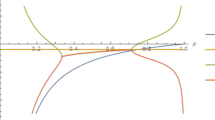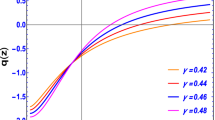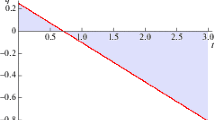Abstract
The accelerated expansion of the Universe constitutes one of the biggest challenges in present-day cosmology. To understand and explain this phenomenon in the framework of general relativity, corrections and extensions to it are required, which make the so-called extended theories of gravity (ETGs). In these theories, the geometry of space-time that represents the gravitational sector at the left hand side of the Einstein field equation \({G_{\mu\nu}}=8\pi{T_{\mu\nu}}\) is necessarily modified. These theories have attracted much attention since the time the accelerated expansion was discovered. A class of these theories known as \(f(R)\) gravity, offers a potent candidacy for this purpose, in addition to matter content modifications. The gravitational sector depending on the Ricci scalar invariant \(R\) is basically replaced with some its general nonlinear function which consists of higher-order curvature terms. In this work, we attempt to realize the late-time accelerated expansion in the context of \(f(R)\) gravity using the dynamical system approach. Analyzing the dynamical system arising from a particular \(f(R)\) model, its stability is studied for the cosmological inferences. The particular model \(f(R)={R^{p}}\exp({qR})\) with \(m=\frac{{R{f_{,RR}}}}{{{f_{,R}}}}=\frac{{p(p-1)+2pqR+{q^{2}}{R^{2}}}}{{p+qR}}\) and \(r=-\frac{{R{f_{,R}}}}{f}=-(p+qR)\) and with the geometric curve \(m(r)=-\frac{{{r^{2}}-p}}{r}\), is studied in this paper. We use the geometric approach for the curve \(m(r)\) in the plane \((r,m)\) which provides some properties of the model. In the case of a matter-dominated era the viability conditions at \(r=-1\), \(m(r)=0\) and \(dm/dr>-1\) are investigated. On the other hand, for the late-time acceleration, however, at \(r=-2\), either of the two conditions \(m(r)=-r-1\) with \(dm/dr<-1\), \(1\geq m>(\sqrt{3}-1)/2\) and \(1\geq m\geq 0\) are sought to fulfill. In the first place, the cosmic content is assumed to comprise matter and radiation only in the absence of a cosmological constant \(\Lambda\). In this case, an interaction of any kind is disregarded. Afterwards, as the second consideration, an interaction term in the presence of a cosmological constant representing dark energy is taken into account. The effects of linear and nonlinear interactions between matter and dark energy are also taken into account orderly in this case. The results are presented for each case, along with a discussion of critical points, their eigenvalues, and the equation of state parameter.













Similar content being viewed by others
References
A. G. Riess et al., “Observational evidence from supernovae for an accelerating universe and a cosmological constant,” Astron. J. 116 (3), 1009 (1998).
S. Perlmutter et al. (Supernova Cosmology Project), “Measurements of \(\Omega\) and \(\Lambda\) from 42 high-redshift supernovae,” Astron. J. 517 (2), 565 (1999).
A. G. Riess et al., “The farthest known supernova: support for an accelerating universe and a glimpse of the epoch of deceleration,” Astron. J. 560 (1), 49 (2001).
https://www.nobelprize.org/prizes/physics/2011/ press-release/
S. Perlmutter, B. P. Schmidt, and A. G. Riess, “The Nobel prize in physics 2011. A. G. Riess, My path to the accelerating Universe,” Nobel Lecture (2011).
D. Huterer and M. S. Turner, “Prospects for probing the dark energy via supernova distance measurements.” Phys. Rev. D 60 (8), 081301 (1999).
S. Perlmutter, M. S. Turner, and M. White, “Constraining dark energy with type Ia supernovae and large-scale structure,” Phys. Rev. Lett. 83 (4), 670 (1999).
N. Aghanim et al., “Planck 2018 results—VI. Cosmological parameters,” Astron. Astrophys. 641, A6 (2020).
C. To et al. (DES Collaboration), “Dark Energy survey year 1 results: cosmological constraints from cluster abundances, weak lensing, and galaxy correlations,” Phys. Rev. Lett. 126 (14), 141301 (2021).
D. Benisty and D. Staicova, “Testing late-time cosmic acceleration with uncorrelated baryon acoustic oscillation dataset,” Astron. Astrophys. 647, A38 (2021).
A. Mazumdar, S. Mohanty, and P. Parashari, “Evidence of dark energy in different cosmological observations,” Eur. Phys. J. Spec. Top. 1–12 (2021).
G. Lemaître, “The beginning of the world from the point of view of quantum theory,” Nature 127 (3210), 706–706 (1931).
H. S. Kragh and D. Lambert, “The context of discovery: Lemaître and the origin of the primeval-atom universe,” Ann. Sci. 64 (4), 445–470 (2007).
A. A. Friedmann, The World as Space and Time (Minkowski Institute Press, 2014).
A. A. Starobinsky, “A new type of isotropic cosmological models without singularity,” Phys. Lett. B 91 (1), 99–102 (1980).
A. H. Guth, “Inflationary universe: A possible solution to the horizon and flatness problems,” Phys. Rev. D 23 (2), 347 (1981).
K. Sato, “First-order phase transition of a vacuum and the expansion of the Universe,” Mon. Not. Roy. Astron. Soc. 195 (3), 467–479 (1981).
D. Kazanas, “Dynamics of the universe and spontaneous symmetry breaking,” Astron. J. 241, L59–L63 (1980).
L. Perivolaropoulos and F. Skara, “Challenges for CDM: An update,” arXiv: 2105.05208.
A. H. Guth, D. I. Kaiser, and Y. Nomura, “Inflationary paradigm after Planck 2013,” Phys. Lett. B 733, 112–119 (2014).
C. Smeenk, “False vacuum: Early universe cosmology and the development of inflation.” In: The Universe of General Relativity (Birkh’auser, Boston, 2005), pp. 223–257.
J. Earman and J. Mosterin, “A critical look at inflationary cosmology,” Philos. Sci. 66 (1), 1–49 (1999).
M. Ishak, “Testing general relativity in cosmology,” Living Rev. Relativ. 22 (1), 1–204 (2019).
M. Z. Mughal and I. Ahmad, “A multi-field tachyon-quintom model of dark energy and fate of the Universe,” Eur. Phys. J. Plus 136 (5), 1–20 (2021).
A. Einstein, “Cosmological considerations in the General Theory of Relativity.” Volume 6: The Berlin Years: Writings, 1914–1917, Doc. 43; Sitzungsber. Preuss. Akad. Wiss. Berlin (Math. Phys.), 421–450 (1917).
A. Einstein, “On the generalized theory of gravitation,” Sci. Am. 182, 13–17 (1950).
T. Padmanabhan, “Cosmological constant—the weight of the vacuum,” Phys. Rep. 380 (5-6), 235–320 (2003).
V. Sahni and A. Starobinsky, “The case for a positive cosmological \(\Lambda\)-term.” Int. J. Mod. Phys. D 9 (04), 373–443 (2000).
E. J. Copeland, M. Sami, and S. Tsujikawa, Dynamics of dark energy. Int. J. Mod. Phys. D 15(11), 1753–1935 (2006).
K. Bamba, S. Capozziello, S. I. Nojiri, and S. D. Odintsov, “Dark energy cosmology: the equivalent description via different theoretical models and cosmography tests,” Astrophys. Space Sci 342 (1), 155–228 (2012).
S. Bahamonde, C. G. Böhmer, S. Carloni, E. J. Copeland, W. Fang, and N. Tamanini, “Dynamical systems applied to cosmology: dark energy and modified gravity,” Phys. Rep. 775, 1–122 (2018).
J. Yoo and Y. Watanabe, “Theoretical models of dark energy,” Int. J. Mod. Phys. D 21 (12), 1230002 (2012).
V. Faraoni and S. Capozziello, “Beyond Einstein gravity,” Fundamental Theories of Physics 170 (2011).
H. A. Buchdahl, “Nonlinear Lagrangians and cosmological theory,” Mon. Not. Roy. Astron. Soc. 150 (1), 1–8 (1970).
B. N. Brejzman, V. T. Gurovich, and V. P. Sokolov, “On the possibility of setting up regular cosmological solutions”, ZhETF 59, 288-294 (1970);
B. N. Brejzman, V. T. Gurovich, and V. P. Sokolov, “On the possibility of setting up regular cosmological solutions,” ZhETF 59, 288-294 (1970); Sov. Phys. JETP 32, 155 (1970).
P. G. Bergmann, “Comments on the scalar-tensor theory,” Int. J. Theor. Phys. 1 (1), 25–36 (1968).
T. Ruzmaikina and A. A. Ruzmaikin, “Quadratic corrections to the Lagrangian density of the gravitational field and the singularity,” Sov. Phys. JETP 30, 372 (1970).
A. De Felice and S. Tsujikawa, ‘f(R) theories,” Living Rev. Relativ. 13 (1), 1–161 (2010).
L. Amendola, A. B. Mayer, S. Capozziello, S. Gottlober, V. Muller, F. Occhionero, and H. J. Schmidt, “Generalized sixth-order gravity and inflation,” Class. Quantum Grav. 10 (5), L43 (1993).
S. Gottlober, H. J. Schmidt, and A. A. Starobinsky, “Sixth-order gravity and conformal transformations,” Class. Quantum Grav. 7 (5), 893 (1990).
A. B. Mayer and H. J. Schmidt, “The de Sitter spacetime as attractor solution in eighth-order gravity,” Class. Quantum Grav. 10 (11), 2441 (1993).
H. J. Schmidt, ‘Variational derivatives of arbitrarily high order and multi-inflation cosmological models,” Class. Quantum Grav. 7 (6), 1023 (1990).
S. Capozziello, S. Carloni, and A. Troisi, “Quintessence without scalar fields,” astro-ph/0303041.
A. Einstein, Title?? Sitzungber. Preuss Akad. Wiss. Phys.-Math. Kl 23 (3) (1925).
S. Capozziello, M. De Laurentis, and V. Faraoni, “A bird’s eye view of f(R)-gravity,” arXiv: 0909.4672.
T. Clifton, P. G. Ferreira, A. Padilla, and C. Skordis, “Modified gravity and cosmology,” Phys. Rep. 513 (1–3), 1–189 (2012).
S. Nojiri, S. D. Odintsov, and V. K. Oikonomou, “Modified gravity theories on a nutshell: inflation, bounce and late-time evolution,” Phys. Rep. 692, 1–104 (2017).
T. P. Sotiriou, “Constraining f(R) gravity in the Palatini formalism,” Class. Quantum Grav. 23 (4), 1253 (2006).
T. P. Sotiriou and S. Liberati, “Metric-affine f(R) theories of gravity,” Ann. Phys. (NY) 322 (4), 935–966 (2007).
R. Ferraro, “f(R) and f(T) theories of modified gravity,” AIP Conference Proceedings 1471 (1), 103–110 (2012).
S. I. Nojiri and S. D. Odintsov, “Introduction to modified gravity and gravitational alternative for dark energy,” Int. J. Geom. Methods Mod. Phys. 4 (01), 115–145 (2007).
T. P. Sotiriou and V. Faraoni, “f(R) theories of gravity,” Rev. Mod. Phys. 82 (1), 451 (2010).
A. De Felice and S. Tsujikawa, “f(R) theories,” Living Rev. Relativ. 13 (1), 1–161 (2010).
S. D. Odintsov and V. K. Oikonomou, “Aspects of axion F(R) gravity,” EPL (EPL-EUROPHYS LETTR) 129 (4), 40001 (2020).
S. Nojiri, S. D. Odintsov, and V. K. Oikonomou, “Constant-roll inflation in F(R) gravity,” Class. Quantum Grav. 34 (24), 245012 (2017).
S. D. Odintsov and V. K. Oikonomou, “Effects of spatial curvature on the f(R) gravity phase space: no inflationary attractor?” Class. Quantum Grav. 36 (6), 065008 (2019).
S. I. Nojiri and S. D. Odintsov, “Unified cosmic history in modified gravity: from F(R) theory to Lorentz non-invariant models,” Phys. Rep. 505 (2-4), 59–144 (2011).
S. D. Odintsov and V. K. Oikonomou, “Reconstruction of slow-roll F(R) gravity inflation from the observational indices,” Ann. Phys. (NY) 388, 267–275 (2018).
S. Capozziello, C. A. Mantica, and L. G. Molinari, “Cosmological perfect fluids in f(R) gravity,” Int. J. Geom. Methods Mod. Phys. 16 (01), 1950008 (2019).
S. Capozziello and M. De Laurentis, “Extended theories of gravity,” Phys. Rep. 509 (4-5), 167–321 (2011).
S. Capozziello, S. I. Nojiri, and S. D. Odintsov, “The role of energy conditions in f(R) cosmology,” Phys. Lett. B 781, 99–106 (2018).
K. Bamba, S. Capozziello, S. I. Nojiri, and S. D. Odintsov, ‘Dark energy cosmology: the equivalent description via different theoretical models and cosmography tests,” Astrophys. Space Sci. 342 (1), 155–228 (2012).
M. Z. Mughal, I. Ahmad, and J. L. García Guirao, “Relativistic cosmology with an introduction to inflation,” Universe 7 (8), 276 (2021).
S. Bekov, K. Myrzakulov, R. Myrzakulov, and D. Sáez-Chillón Gómez, “General slow-roll inflation in f(R) gravity under the Palatini approach,” Symmetry 12 (12), 1958 (2020).
S. I. Nojiri and S. D. Odintsov, “Modified f(R) gravity consistent with realistic cosmology: From a matter dominated epoch to a dark energy universe,” Phys. Rev. D 74 (8), 086005 (2006).
K. Bamba and S. D. Odintsov, “Inflationary cosmology in modified gravity theories,” Symmetry 7 (1), 220–240 (2015).
T. B. Vasilev, M. Bouhmadi-López, and P. Martín-Moruno, “Little rip in classical and quantum f(R) cosmology,” Phys. Rev. D 103 (12), 124049 (2021).
L. Amendola and S. Tsujikawa, Dark Energy: Theory and Observations (Cambridge University Press, 2010).
S. Capozziello, and M. De Laurentis, “F(R) theories of gravitation,” Scholarpedia 10 (2), 31422 (2015).
L. Amendola, R. Gannouji, D. Polarski, and S. Tsujikawa, “Conditions for the cosmological viability of f(R) dark energy models,” Phys. Rev. D 75(8), 083504 (2007).
P. Shah and G. C. Samanta, “Stability analysis for cosmological models in f(R) gravity using dynamical system analysis,” Eur. Phys. J. C 79 (5), 1–9 (2019).
L. Amendola and S. Tsujikawa, “Phantom crossing, equation-of-state singularities, and local gravity constraints in f(R) models,” Phys. Lett. B 660 (3), 125–132 (2008).
W. Hu and I. Sawicki, “Models of f(R) cosmic acceleration that evade solar system tests,” Phys. Rev. D 76 (6), 064004 (2007).
S. Capozziello and S. Tsujikawa, “Solar system and equivalence principle constraints on f(R) gravity by the chameleon approach,” Phys. Rev. D 77 (10), 107501 (2008).
K. Bamba, “Equation of state for dark energy in modified gravity theories,” In: Quest for the Origin of Particles and the Universe (World Scientific, 2013), pp. 73–79.
F. Arevalo, A. P. Bacalhau, and W. Zimdahl, “Cosmological dynamics with nonlinear interactions,” Astrophys. Space Sci. 29 (23), 235001 (2012).
R. Garcia-Salcedo, T. Gonzalez, and I. Quiros, “Phase space dynamics of non-gravitational interactions between dark matter and dark energy: The case of ghost dark energy,” arXiv: 1211.2738.
H. Golchin, S. Jamali, and E. Ebrahimi, “Interacting dark energy: Dynamical system analysis,” Int. J. Mod. Phys. D 26 (09), 1750098 (2017).
J. H. He and B. Wang, “Effects of the interaction between dark energy and dark matter on cosmological parameters,” J. Cosmol. Astropart. Phys. 2008 (06), 010 (2008).
Y. L. Bolotin, A. Kostenko, O. A. Lemets, and D. A. Yerokhin, “Cosmological evolution with interaction between dark energy and dark matter,” Int. J. Mod. Phys. D 24 (03), 1530007 (2015).
Author information
Authors and Affiliations
Corresponding authors
Ethics declarations
The authors declare that they have no conflicts of interest.
Rights and permissions
About this article
Cite this article
Mughal, M.Z., Ahmad, I. A Study of the Accelerating Universe in \(\boldsymbol{f(R)}\) Modified Gravity Using the Dynamical System Approach. Gravit. Cosmol. 28, 37–58 (2022). https://doi.org/10.1134/S0202289322010091
Received:
Revised:
Accepted:
Published:
Issue Date:
DOI: https://doi.org/10.1134/S0202289322010091




